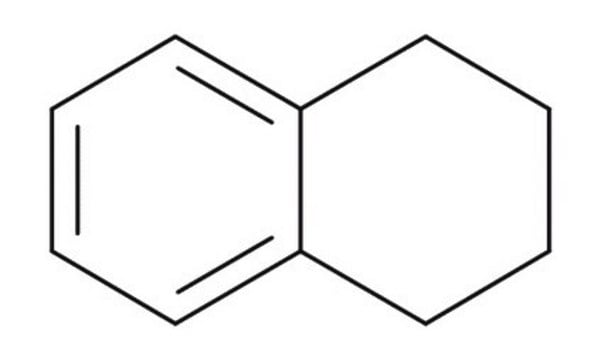D251
Decahydronaphthalene, mixture of cis + trans
reagent grade, 98%
Synonym(s):
Decalin™
About This Item
Recommended Products
grade
reagent grade
Quality Level
vapor density
4.76 (vs air)
vapor pressure
42 mmHg ( 92 °C)
741 mmHg ( 188 °C)
Assay
98%
form
liquid
autoignition temp.
482 °F
expl. lim.
0.7-4.9 %, 100 °F
refractive index
n20/D 1.474 (lit.)
bp
189-191 °C (lit.)
mp
−125 °C (lit.)
density
0.896 g/mL at 25 °C (lit.)
SMILES string
C1CCC2CCCCC2C1
InChI
1S/C10H18/c1-2-6-10-8-4-3-7-9(10)5-1/h9-10H,1-8H2
InChI key
NNBZCPXTIHJBJL-UHFFFAOYSA-N
Looking for similar products? Visit Product Comparison Guide
Related Categories
General description
Application
- Distannoxane-catalyzed synthesis of aliphatic polyesters via polycondensation.
- Intramolecular carbonyl-ene cyclocondensation of oxygenated o-phenylallylbenzaldehydes to synthesize substituted naphthalenes.
Legal Information
Signal Word
Danger
Hazard Statements
Precautionary Statements
Hazard Classifications
Acute Tox. 3 Inhalation - Aquatic Acute 1 - Aquatic Chronic 1 - Asp. Tox. 1 - Eye Dam. 1 - Flam. Liq. 3 - Skin Corr. 1C
Storage Class Code
3 - Flammable liquids
WGK
WGK 3
Flash Point(F)
134.6 °F - closed cup
Flash Point(C)
57 °C - closed cup
Certificates of Analysis (COA)
Search for Certificates of Analysis (COA) by entering the products Lot/Batch Number. Lot and Batch Numbers can be found on a product’s label following the words ‘Lot’ or ‘Batch’.
Already Own This Product?
Find documentation for the products that you have recently purchased in the Document Library.
Customers Also Viewed
Our team of scientists has experience in all areas of research including Life Science, Material Science, Chemical Synthesis, Chromatography, Analytical and many others.
Contact Technical Service















